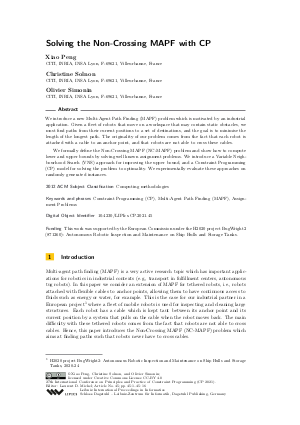Solving the Non-Crossing MAPF with CP
Authors Xiao Peng, Christine Solnon, Olivier Simonin
-
Part of:
Volume:
27th International Conference on Principles and Practice of Constraint Programming (CP 2021)
Part of: Series: Leibniz International Proceedings in Informatics (LIPIcs)
Part of: Conference: International Conference on Principles and Practice of Constraint Programming (CP) - License:
 Creative Commons Attribution 4.0 International license
Creative Commons Attribution 4.0 International license
- Publication Date: 2021-10-15
File

PDF
LIPIcs.CP.2021.45.pdf
- Filesize: 1.04 MB
- 16 pages
Document Identifiers
Subject Classification
ACM Subject Classification
- Computing methodologies
Keywords
- Constraint Programming (CP)
- Multi-Agent Path Finding (MAPF)
- Assignment Problems
Metrics
- Access Statistics
-
Total Accesses (updated on a weekly basis)
0PDF Downloads0Metadata Views
Abstract
We introduce a new Multi-Agent Path Finding (MAPF) problem which is motivated by an industrial application. Given a fleet of robots that move on a workspace that may contain static obstacles, we must find paths from their current positions to a set of destinations, and the goal is to minimise the length of the longest path. The originality of our problem comes from the fact that each robot is attached with a cable to an anchor point, and that robots are not able to cross these cables. We formally define the Non-Crossing MAPF (NC-MAPF) problem and show how to compute lower and upper bounds by solving well known assignment problems. We introduce a Variable Neighbourhood Search (VNS) approach for improving the upper bound, and a Constraint Programming (CP) model for solving the problem to optimality. We experimentally evaluate these approaches on randomly generated instances.
Cite As Get BibTex
Xiao Peng, Christine Solnon, and Olivier Simonin. Solving the Non-Crossing MAPF with CP. In 27th International Conference on Principles and Practice of Constraint Programming (CP 2021). Leibniz International Proceedings in Informatics (LIPIcs), Volume 210, pp. 45:1-45:16, Schloss Dagstuhl – Leibniz-Zentrum für Informatik (2021)
https://doi.org/10.4230/LIPIcs.CP.2021.45
BibTex
@InProceedings{peng_et_al:LIPIcs.CP.2021.45,
author = {Peng, Xiao and Solnon, Christine and Simonin, Olivier},
title = {{Solving the Non-Crossing MAPF with CP}},
booktitle = {27th International Conference on Principles and Practice of Constraint Programming (CP 2021)},
pages = {45:1--45:16},
series = {Leibniz International Proceedings in Informatics (LIPIcs)},
ISBN = {978-3-95977-211-2},
ISSN = {1868-8969},
year = {2021},
volume = {210},
editor = {Michel, Laurent D.},
publisher = {Schloss Dagstuhl -- Leibniz-Zentrum f{\"u}r Informatik},
address = {Dagstuhl, Germany},
URL = {https://drops.dagstuhl.de/entities/document/10.4230/LIPIcs.CP.2021.45},
URN = {urn:nbn:de:0030-drops-153367},
doi = {10.4230/LIPIcs.CP.2021.45},
annote = {Keywords: Constraint Programming (CP), Multi-Agent Path Finding (MAPF), Assignment Problems}
}
Author Details
Funding
This work was supported by the European Commission under the H2020 project BugWright2 (871260): Autonomous Robotic Inspection and Maintenance on Ship Hulls and Storage Tanks.
References
-
Mark de Berg, Otfried Cheong, Marc van Kreveld, and Mark Overmars. Computational Geometry: Algorithms and Applications. Springer-Verlag, 3rd ed. edition, 2008.

-
S. Bhattacharya, M. Likhachev, and V. Kumar. Topological constraints in search-based robot path planning. Autonomous Robots, 33(3):273-290, 2012.

-
Rainer E. Burkard and Eranda Çela. Linear assignment problems and extensions. Handbook of Combinatorial Optimization, pages 75-149, 1999.

-
J. Carlsson, B. Armbruster, Saladi Rahul, and Haritha Bellam. A bottleneck matching problem with edge-crossing constraints. Int. J. Comput. Geom. Appl., 25:245-262, 2015.

- Geoffrey Chu and Peter J. Stuckey. Chuffed solver description, 2014. Available at URL: http://www.minizinc.org/challenge2014/description_chuffed.txt.
-
Susan Hert and Vladimir J. Lumelsky. The ties that bind: Motion planning for multiple tethered robots. Robotics Auton. Syst., 17(3):187-215, 1996.

-
H. W. Kuhn. The hungarian method for the assignment problem. Naval Research Logistics Quarterly, 2(1‐2):83-97, 1955.

-
Jean-Claude Latombe. Robot Motion Planning. Kluwer Academic Publishers, 1991.

- Jiaoyang Li, Pavel Surynek, Ariel Felner, Hang Ma, T. K. Satish Kumar, and Sven Koenig. Multi-agent path finding for large agents. Proceedings of the AAAI Conference on Artificial Intelligence, 33(01):7627-7634, July 2019. URL: https://doi.org/10.1609/aaai.v33i01.33017627.
-
Tomás Lozano-Pérez and Michael A. Wesley. An algorithm for planning collision-free paths among polyhedral obstacles. Commun. ACM, 22(10):560–570, 1979.

-
Nenad Mladenovic and Pierre Hansen. Variable neighborhood search. Comput. Oper. Res., 24(11):1097-1100, 1997.

-
Nicholas Nethercote, Peter J. Stuckey, Ralph Becket, Sebastian Brand, Gregory J. Duck, and Guido Tack. Minizinc: Towards a standard CP modelling language. In Principles and Practice of Constraint Programming - CP 2007, volume 4741 of LNCS, pages 529-543. Springer, 2007.

-
David W. Pentico. Assignment problems: A golden anniversary survey. Eur. J. Oper. Res., 176(2):774-793, 2007.

-
Putnam. Problem a4, 1979.

- Guni Sharon, Roni Stern, Ariel Felner, and Nathan R. Sturtevant. Conflict-based search for optimal multi-agent pathfinding. Artificial Intelligence, 219:40-66, 2015. URL: https://doi.org/10.1016/j.artint.2014.11.006.
-
S. Thomas, Dipti Deodhare, and M. N. Murty. Extended conflict-based search for the convoy movement problem. IEEE Intelligent Systems, 30:60-70, 2015.

-
Thayne T. Walker, Nathan R. Sturtevant, and Ariel Felner. Extended increasing cost tree search for non-unit cost domains. In Proceedings of the 27th International Joint Conference on Artificial Intelligence, IJCAI'18, page 534–540. AAAI Press, 2018.

-
J. Yu and S. LaValle. Structure and intractability of optimal multi-robot path planning on graphs. In In Proceedings of the AAAI Conference on Artificial Intelligence (AAAI), pages 1444-1449, 2013.

- Xu Zhang and Quang-Cuong Pham. Planning coordinated motions for tethered planar mobile robots. Robotics and Autonomous Systems, 118:189-203, 2019. URL: https://doi.org/10.1016/j.robot.2019.05.008.
